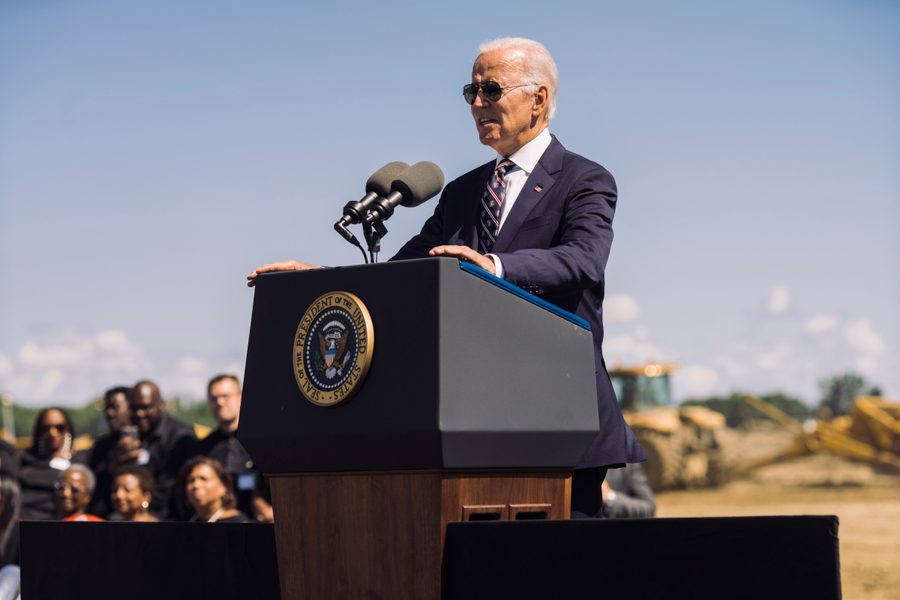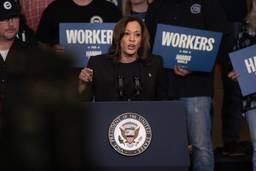Grading President Biden’s Economic Record
Rapid job growth and increased worker bargaining power are very good—there’s a whole lot more progressive policy that could be done.
Max B. Sawicky

In 1980, one of Ronald Reagan’s most powerful attacks on incumbent President Jimmy Carter was said to be his question, “Are you better off than you were four years ago?” Reagan went on to narrow the purview of his question to voters’ ability to buy things, the unemployment rate and “respect for America” in other countries.
In point of fact, U.S. economic performance from 1976 to 1980 was not great, but it wasn’t terrible either. Various income measures and the unemployment rate in October of 1980 were about the same as when Carter took office in 1977. You could say the failure to improve much, or at all, supported Reagan’s challenge. The key point is that a recession began in January of 1980 and the economy reached its nadir (‘trough’ in economists’ lingo) in July, which is very bad timing for an incumbent president in an election year.
Now, ahead of the 2022 midterm elections, the same question might be considered with respect to the Biden administration (albeit two years into a Democratic presidency rather than four). It is common to credit or criticize presidents with respect to the jobs they “create.” Actually, presidents don’t directly create jobs, except when they choose to enlarge the federal workforce, or, in former President Donald Trump’s case, when jobs are handed to dissolute family members and cronies.
The reality is that fiscal policy combined with monetary policy affects job creation. Fiscal policy is the doing of Congress, perhaps with relevant leadership from the White House. A salient case of the latter was Biden’s sizeable American Rescue Plan which injected spending into the economy and invested in social programs. Monetary policy is conducted by the independent Federal Reserve. Crediting or blaming the president for good or bad job creation is generally a stretch.
Even so, this metric is flogged all the time by the media and in political rhetoric. From this standpoint, the Biden administration has been spectacular. Of course, it’s easier to “create jobs” when you’re starting from the pits, where Trump had left the United States in early 2021 thanks in large part to the pandemic.
Progressive criteria for government action ought to be more demanding, of course. And if you want cheerleading for the Democratic Party, it’s best to look elsewhere. More GDP is not an automatic gain for the working class.
Even so, the exceptionally low unemployment we presently enjoy is nothing to be sneezed at. It should be understood that a “tight” labor market, meaning very low unemployment — employers chasing workers, rather than the jobless reduced to accepting employment on less favorable terms — carries a myriad of economic and social benefits. Chief among these benefits are higher wages, especially for those at the lower end of the income scale. Moreover, an unemployment rate that is higher than necessary, as it was for the nearly 40 years from 1979 to 2017, pulls down median wages.
Until some recent signs of backsliding, the Biden administration remained blissfully unexcited by federal budget deficits. In fact, without trying very hard, it has reduced them from the stratospheric levels reached during the Trump administration. One of the fruits of this arguably benign neglect has been the precipitous increase in employment under Biden.
Unfortunately, this achievement for employment is now endangered by the Federal Reserve’s ongoing and misdirected over reaction to the spike in inflation, which comes in the form of sharp increases in interest rates that are intended to impede job growth and wages. While price increases have caused pain for working people, the primary causes for this rise in inflation are not related to the administration’s domestic economic agenda, nor to wage increases that the Fed is determined to suppress. The more likely suspects are supply chain issues linked to the pandemic and the war in Ukraine.
Jobs are good, but we want to get beyond subsistence. After all, work doesn’t pay enough. People need support from the public sector. Families should be able to accumulate wealth, to achieve economic security and to raise children in a healthy environment. Getting to full employment is only the first step.
In the matter of family support, Biden came out of the gate fast with his expansion of the Child Tax Credit (CTC) and boosted unemployment benefits. Unfortunately, the expanded CTC, which helped lead to a significant drop in the child poverty rate, was not renewed, due to the intransigence of conservative Democrats including Sen. Joe Manchin (W.V.). Revival of such benefits will likely depend on the outcome of the midterm elections, requiring Democrats to hold the House and gain enough net gains in the Senate to cancel out the obstructions of Manchin and Sen. Kyrsten Sinema (D-Ariz.).
The Inflation Reduction Act (IRA), signed into law in August, provides family support for health benefits, in the form of the extension of expanded Obamacare subsidies. It has been well-known that in the original Affordable Care Act bill, subsidy levels for the purchase of private health insurance were grossly inadequate, which this bill helps resolve.
The IRA also includes some other supports for working-class Americans, though not nearly as much as would have been on offer under the Build Back Better framework (child care, universal Pre-K, affordable housing, etc.) — another casualty of the Manchin-Sinema veto.
The other shoe that dropped under Biden was relief for holders of student loans — up to $20,000 for those who received Pell grants. The college affordability problem remains a long way from solution, yet a taste of relief can provoke calls for more in the future. Some ex-students who carry debt are close to retirement. The unfinished agenda is manifest. A more congenial environment in Congress would likely make possible further gains for students. But for the time being, any debt relief is a welcome policy development.
Income support of these types facilitates wealth accumulation in several ways, including by reducing the need to increase credit card balances, which reduces net wealth. By making student loans easier to carry, access to college is widened, and the premium for lifetime earnings resulting from higher educational attainment remains significant. Lower student loan balances make it easier for families to qualify for mortgages, and home ownership is historically the first step for families to build wealth.
It also pays to consider the dimensions of race and gender in this context. People of color are disproportionately found in lower income classes, so progressive cash benefits such as the expanded CTC or unemployment insurance are, in effect, anti-racist. The same applies to student loan relief, which evidence suggests will help reduce the Black-white wealth gap. When it comes to women, lower income families are disproportionately families with children headed by women, with no additional caregiver present. Benefits geared to children are good for gender justice.
Public support for families is only one part of what we should hope for. There is also the extent to which working people can secure income and benefits themselves from their employers, which can be seen by progress in the field of labor rights that strengthens worker bargaining power. You can’t measure it with government spending, but there are other signs.
Today there is ferment in labor, particularly visible with organizing at mass employers such as Amazon and Starbucks. Rebuilding support for labor rights would be very well-timed. It’s been a long time since the trade union movement had an energetic advocate in the White House. I’d say not since 1968, actually.
A recent report from the Economic Policy Institute details a number of positive reforms from the Biden administration, often below-the-radar, but including strong, high-profile appointments to the Department of Labor, the National Labor Relations Board, the Federal Reserve and the Supreme Court. Incidentally, these appointments reflect a serious commitment to anti-racism. Relatedly, if we consider the well-being of immigrants in an anti-racist, labor framework, the reversal of some of the most xenophobic Trump policies is also noteworthy. When it comes to the PRO Act, Biden has been vocal in his support for the omnibus labor legislation but, again, resistance from certain Democratic senators has stymied its passage in Congress.
An economically thriving population won’t mean much if the planet becomes unlivable. Therein lies the significance of the IRA for climate change. While there is clearly more to be done, the IRA’s support from long-standing leaders in the movement to combat climate change attests to the fact that some ice has at least been broken (no pun intended). Here as well, the table is set for further progress.
One other accomplishment of Biden was something he did not do: write more neoliberal trade agreements.
The bottom line is that under difficult circumstances, the Democratic Party can be credited with enabling rapid job growth, significant (albeit temporary) family income support, an alleviation of debt burdens on the working class, commitments to fight racism and the first serious attempt to curb climate change.
The emphasis on labor and social support, the neglect of hackneyed neoliberal obsessions over budget deficits and free trade, combined with the most recent ‘name the enemy’ initiative on Trumpist fascism, puts the Biden administration decidedly to the left of Obama and the Clintons. Further grassroots mobilization can help yield better policy decisions.
It is always possible to denigrate any individual measure as inadequate, relative to some ideal standard. If that standard is not attainable in the foreseeable future, it is really beside the point. Historically, it has been incrementalist “salami tactics” that grow the U.S. welfare state. Over time, the slices pile up.
Max B. Sawicky is an economist and writer in Virginia, formerly with the Government Accountability Office and the Economic Policy Institute. He is a Senior Research Fellow at the Center for Economic and Policy Research and runs the MaxSpeak, You Listen! blog at sawicky.substack.com.








